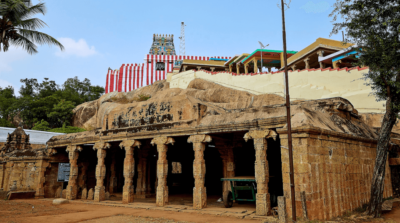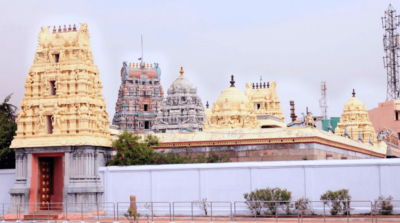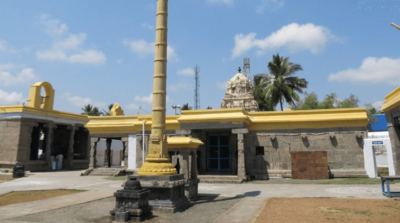Chennimalai Murugan Temple
Chennimalai is a prominent hill located near Erode in the state of Tamil Nadu, India, famous for the revered Chennimalai Murugan Temple. This sacred site is dedicated to Lord Murugan, also known as the god of war and victory, and is considered an important pilgrimage center in the region. The hill stands at about 400 meters above sea level and is surrounded by beautiful natural landscapes, offering both spiritual and scenic appeal.
The Chennimalai Murugan Temple is known for its rich spiritual heritage and is visited by thousands of devotees, particularly during major festivals like Thaipusam and Panguni Uthiram. Pilgrims often climb the 1,320 steps to reach the temple, though a motorable road is also available. The temple is associated with the legend of Lord Murugan’s triumph over the demon Surapadman, symbolizing the victory of good over evil.
Chennimalai is not only a spiritual destination but also a peaceful retreat for those looking to enjoy nature. The temple’s Dravidian architecture, coupled with its serene hilltop location, provides an atmosphere of calm and devotion, making it a significant site for both worship and exploration.
Chennimalai Murugan Temple History
At a distance of about 3 miles from Chennimalai, there is a village called Kodumanal on the banks of the Noyal River. Archaeologists say it was once a metropolis and subject to a small river. It is also said that they are investigating to learn more interesting news. Centuries ago, a farmer in the city had hundreds of cows on his large farm. There was also a fertile Karambasu in it. It is customary to keep the cows locked up by the herdsman. The worker informed his farmer that a cow had been without milk in her lap for some days. When the farmer observed this for several days, when the cows came back to the tank together in the evening, the cow alone separated and automatically scratched all the milk in its lap at a certain place and then joined the herd of cows for a few days. After digging about 5 or 6 feet deep, everyone found a stone with an amazingly full face. The farmer became enraptured and took the vigraha, saying that the Lord who had possessed him had come and absorbed the radiance of its face and become mesmerized.
After examining the vigraha, he found that it had good work up to the waist, and the face was very brilliant, but below the waist, up to the foot, it was rough and rough. Everyone who saw this got scared and stopped cleaning further. Historians believe that the farmer repented of his misdeeds and was happy that the Lord loved to remain like this and was worshipped with reverence. He erected a small temple on the nearby hill and consecrated this statue, which is now sitting on the throne as Thandayuthapanimurtha on the Chennimalai hill. As proof of this, even today we can see the auspicious Dandapani Murtham with full effulgence and no work until it turns below the waist. About 3000 years old, this temple was built during the Chola dynasty. When the king was going to all the temples without Brahmahati dosha, he was bathing on the bank of the Noyal River.
Seeing this mountain and coming to the top of the hill with his troops, Lord Muruga came as a priest, worshipped himself, and removed the Brahmahati dosha from the king. It is said that the Sivalaya Chola king settled a monk named Deivasikamaniyar from Tirukkadavur at a place called Tiruvindapuram (Phitariyur) near this var. Sage Saravana, who was born into the family of Siva and had Satya Gnani as his guru, wanted to know the history of Chennimalai and worshipped Lord Muruga. He went to Kanchipuram as Lord Muruga had blessed him through Asariri, wrote the history of Siragiri from Seppet to another Seppet, and enjoyed seeing all the glories in Chennimalai as well as Seppete. Lord Muruga appeared to Sage Saravana in six and one-faced forms. Sage Saravana Samadhi is on this hill.
Thala Puranam

Thala Puranam: Once upon a time Anandan a.k.a Nagarjuna and Vayu Deva were contending that each of them was superior and important. So there was a fight between them to prove their strength. When Anandan embraced Mahameru (Big hill) and held firmly, Vayu Deva responded by blowing strongly. As a result, the head (Peak) of Mahameru was blown away and fell at Poondurai (Today Perundurai) town. This peak of Mahameru is known as Sira giri, Sigara giri, Pushpa giri, Makutagiri or Chennimalai(The head of hills).
Thala Varalaru: 1. About 3 miles from Chennimalai, on the banks of Noyyal River, there is a village named Kodumanal&rsquo. It was once a flourishing ancient trade city known as Kodumanam, as inscribed in Patittrupathu of Sangam literature. The place is an important archaeological site, under the control of the State Archaeological Department of Tamil Nadu. Archaeological Survey suggests that, once upon a time, this village used to be a big town and was ruled by a petty king.
The research on this subject is still continuing to unearth more information. Hundreds of years ago there lived a Landlord in this town who had hundreds of dairy cows in his farm, one among them was a Black Colour Cow (Karam Pasu). Every day the cowherd locks up all the cows in the evening after they have grazed the whole day. The cowherd noticed that there was no milk in the udder of the Karam Pasu for a few days and informed the Land Lord. The landlord also observed for some time that during the evening, when all the cows come back after grazing, this Karam Pasu used to separate from the rest and proceed to a particular spot and discharge the milk by itself. He decided to dig the spot where the cow flows its milk every day. On digging about 5 to 6 ft a beautiful Statue of Lord Muruga was found. He was ecstatic on finding the idol.
Further, he noticed that the idol was beautifully sculpted up to the hip and the lower portion was rough. The best artisan was summoned to complete the job. Everyone was shocked to see that on the first chisel, the idol started to bleed. The landlord realized that this is God’s will to be the way it was. So he consecrated this idol of Lord Dandayudapani on a nearby hill, which is today known as Chennimalai hill. Even today one can see lthe ower portion of the Moolavar Vigraham is still the same way.
Chennimalai Temple Pooja Timing
| Fees Description | Fees (INR) |
| Nichiyathaartham | 150 |
| Mudi Kaanikai | 30 |
| Special Entrance | 100 |




